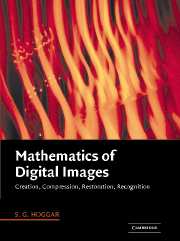Book contents
- Frontmatter
- Contents
- Preface
- Introduction
- A word on notation
- List of symbols
- Part I The plane
- Part II Matrix structures
- Part III Here's to probability
- Part IV Information, error and belief
- Part V Transforming the image
- 14 The Fourier Transform
- 15 Transforming images
- 16 Scaling
- Part VI See, edit, reconstruct
- References
- Index
14 - The Fourier Transform
from Part V - Transforming the image
Published online by Cambridge University Press: 05 November 2012
- Frontmatter
- Contents
- Preface
- Introduction
- A word on notation
- List of symbols
- Part I The plane
- Part II Matrix structures
- Part III Here's to probability
- Part IV Information, error and belief
- Part V Transforming the image
- 14 The Fourier Transform
- 15 Transforming images
- 16 Scaling
- Part VI See, edit, reconstruct
- References
- Index
Summary
The Fourier Transform is a wonderful way of splitting a function into helpful parts, possibly modifying those parts and putting them back together again. One gains insight and/or the power to change things in a desired direction. Here we are particularly interested in its value for interpreting and restoring digital image data. Although the story of the Fourier Transform really begins with the so-called continuous case, where the definitions are integrals, our main concern is with the discrete version, which in any case is what is generally used when implementing even the continuous transform. We come to the continuous case second.
We begin in Section 14.1 with basic definitions and tools rooted in simple yet powerful properties of the complex numbers. We introduce filtering and the Convolution Theorem, two reasons for the wide use of the transform. Redundancy in the DFT is utilised to arrive at the Fast Fourier Transform (FFT), which reduces the complexity of calculation from O(N2) to O(N log2N), another reason for the DFT's ubiquity.
The short Section 14.2 introduces the Continuous Fourier Transform and its tool the Dirac delta function, concluding with the highly desirable properties listed in Table 14.2. In Section 14.3 we explore connections between the three types of Fourier Transform: Fourier series, the continuous transform, and the DFT; noting that for a finite interval appropriately sampled the DFT is a good approximation to the continuous version.
Information
- Type
- Chapter
- Information
- Mathematics of Digital ImagesCreation, Compression, Restoration, Recognition, pp. 523 - 559Publisher: Cambridge University PressPrint publication year: 2006
